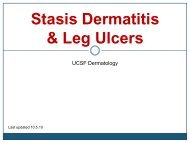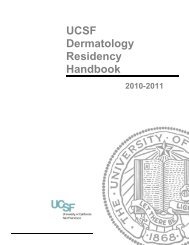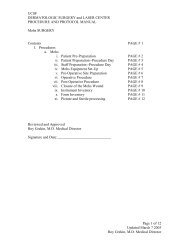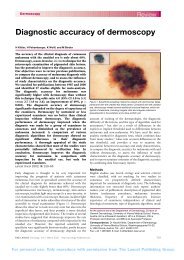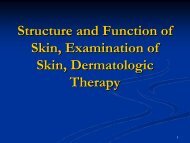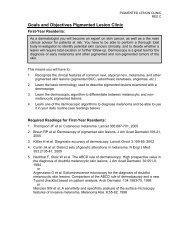An overview of sexually transmitted diseases. Part III ... - Dermatology
An overview of sexually transmitted diseases. Part III ... - Dermatology
An overview of sexually transmitted diseases. Part III ... - Dermatology
Create successful ePaper yourself
Turn your PDF publications into a flip-book with our unique Google optimized e-Paper software.
410 Czelusta, Yen-Moore, and Tyring J AM ACAD DERMATOL<br />
SEPTEMBER 2000<br />
chancroid, have been associated with an increased<br />
risk <strong>of</strong> acquiring and transmitting HIV. One estimation<br />
suggests that STDs increase the overall risk <strong>of</strong><br />
acquiring HIV about 3 to 5 times. 3 Cross-sectional<br />
studies performed in Nairobi, Kenya have consistently<br />
found that HIV seropositivity was more<br />
common in persons with either a history or clinical<br />
evidence <strong>of</strong> genital ulcer disease, 4-7 and one<br />
prospective study from this same region showed an<br />
increased risk <strong>of</strong> seroconversion in patients with<br />
genital ulcer disease. 8 Similarly, Telzak et al 9 found<br />
that 2.9% <strong>of</strong> men with genital ulcer disease turned<br />
HIV-positive, whereas only 1% <strong>of</strong> men without genital<br />
ulcer disease seroconverted. Clearly, a relationship<br />
between genital ulcer disease and HIV transmission<br />
exists; subsequently, prevention <strong>of</strong> genital ulcer<br />
disease should decrease transmission <strong>of</strong> HIV. A<br />
Tanzanian study showed that communities that<br />
improved their recognition and treatment <strong>of</strong> STDs<br />
saw a decrease in the incidence <strong>of</strong> HIV infection in<br />
their population. 10 This is the first documented<br />
intervention involving treatment <strong>of</strong> STDs that was<br />
associated with a decrease in HIV incidence in a<br />
defined population. Thus, through the early recognition<br />
and treatment <strong>of</strong> all STDs, including genital<br />
ulcer disease, HIV transmission can be reduced.<br />
Numerous studies have isolated HIV from genital<br />
ulcer exudates. 11-14 Mechanisms by which genital<br />
ulcer disease appear to facilitate HIV transmission<br />
have been suggested. Disruption <strong>of</strong> the genital<br />
mucosa is associated with the recruitment <strong>of</strong> inflammatory<br />
cells such as CD4 + T lymphocytes and<br />
macrophages. The presence <strong>of</strong> these cells can facilitate<br />
transmission <strong>of</strong> HIV virions from HIV-infected<br />
persons to uninfected persons or provide additional<br />
targets for HIV entry in HIV-negative persons who<br />
are being exposed to the virus. 14-17<br />
Studies implicating the specific agents <strong>of</strong> genital<br />
ulcer disease have focused mostly on genital herpes,<br />
syphilis, and chancroid. Several reports have shown an<br />
association between genital HSV lesions and the acquisition<br />
<strong>of</strong> HIV infection in the affected population.<br />
4,9,18-23 Keet et al 23 showed in a prospective<br />
cohort that pre-existing herpes simplex virus type 2<br />
(HSV-2) seropositivity was a predictor <strong>of</strong> HIV seroconversion.<br />
HIV virions have been shown in HSV ulcers, 24<br />
and in one study HIV RNA was isolated from herpetic<br />
lesions on 67% <strong>of</strong> the days that lesions were present. 13<br />
Similarly, arguments implicating syphilis and chancroid<br />
in the acquisition <strong>of</strong> HIV can be made. Two studies<br />
from Baltimore document strong associations<br />
between HIV seroconversion and either positive<br />
syphilis serology or a history <strong>of</strong> syphilis. 25,26 One<br />
cross-sectional study from Kenya found a similar association<br />
5 ; however, the difficulty in making this associ-<br />
ation statistically significant may reflect the difficulty<br />
in identifying cases <strong>of</strong> syphilis with active genital<br />
ulcers during the study. 8 <strong>An</strong> outbreak <strong>of</strong> chancroid in<br />
Jackson, Mississippi showed a strong association<br />
between this infection and HIV seropositivity, 27 and<br />
most <strong>of</strong> the ulcers in an aforementioned Kenyan<br />
study were due to chancroid and were associated<br />
with increased HIV seropositivity. 6 Lymphogranuloma<br />
venereum and granuloma inguinale are rare <strong>diseases</strong>,<br />
and, as such, they have not been extensively studied<br />
in relation to HIV transmission. Granuloma inguinale<br />
has been associated with a significant number <strong>of</strong> HIV<br />
infections, 28 and its eradication (in an effort to prevent<br />
HIV transmission) has been suggested. 29<br />
Clinical features and treatment<br />
Genital herpes. Genital herpes is the most common<br />
cause <strong>of</strong> genital ulceration worldwide, 30 and its<br />
association with HIV was noticed as early as 1981. 31<br />
Although genital herpes is most commonly caused<br />
by HSV-2, an increasing number <strong>of</strong> cases are suspected<br />
to be caused by HSV-1. 1,32 In HIV-infected<br />
patients, genital herpes can result in severe and atypical<br />
clinical presentations, and treatment may<br />
require increased doses <strong>of</strong> antiviral medications.<br />
Suppressive therapy for HSV appears to significantly<br />
improve survival in HIV-positive patients.<br />
Clinically, HIV-infected patients may experience<br />
an increased number and size <strong>of</strong> lesions in both primary<br />
and reactivated HSV infections as compared<br />
with HIV-uninfected patients. 31,33,34 The vesicles and<br />
ulcers are more painful and heal slower than those<br />
experienced by an immunocompetent host. 35 As<br />
CD4 cell counts drop and immunosuppression worsens,<br />
recurrent outbreaks increase in frequency and<br />
severity. 36,37 Chronic HSV-2 ulcers <strong>of</strong> more than 1<br />
month in duration are an AIDS-defining illness in<br />
HIV-infected patients. 38,39<br />
Atypical HSV presentations occur relatively <strong>of</strong>ten<br />
in HIV-infected patients. <strong>Part</strong>icularly severe lesions<br />
have been reported on patients’ lower backs, buttocks,<br />
or perianal regions, and these lesions may<br />
expand to 20 cm in diameter (Fig 1). 31,40 Such ulcers<br />
commonly become impetiginized and require intensive<br />
long-term therapy. 31 Several case reports<br />
describe HSV-2 presenting as hyperkeratotic verrucous<br />
lesions resembling condyloma in severely<br />
immunocompromised patients. 41-44 These masses<br />
can become large 41,43 and may represent concurrent<br />
HSV and cytomegalovirus infection. 44 A recent<br />
report describes a patient with a pseudotumor <strong>of</strong> the<br />
tongue that was discovered to be an atypical recurrence<br />
<strong>of</strong> HSV-2. 45 HSV may also cause esophagitis,<br />
hepatitis, pneumonitis, or life-threatening disseminated<br />
infections in AIDS patients. 46



